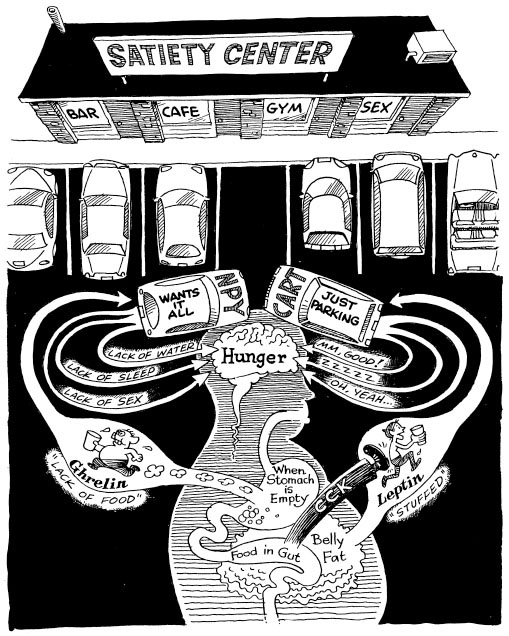
Полная версия
You: On a Diet plus Collins GEM Calorie Counter Set
Scientists found how ghrelin works accidentally: in gastric bypass surgery, doctors cut out the part of the stomach that secretes ghrelin. They soon realized that it wasn’t just the smaller stomach but the reduced ghrelin production that helped surgery patients eat less food. The eat-everything signal was shut off, clearing the way for the satiety center to take care of its business.
Ghrelin Is the Gremlin: The Hormone of Hunger
Your stomach and intestines do more than hold food and produce Richter-worthy belches. When your stomach’s empty, they release a feisty little chemical called ghrelin. When your stomach’s growling, it’s this gremlin of a hormone that’s controlling your body’s offense; it sends desperate messages that you need more points, you need to score, you need to FedEx the chili dogs to the GI tract immediately. Ghrelin makes you want to eat—by stimulating NPY. YOU-reka! To make things worse, when you diet through deprivation, the increased ghrelin secretion sends even more signals to eat, overriding your willpower and causing chemical reactions that give you little choice but to line your tongue with bits of beef jerky.

Ghrelin also promotes eating by increasing the secretion of growth hormone (ghre is the Indo-European root word for “growth”). So when you increase ghrelin levels, you stimulate that growth hormone to kick in, and growth hormone builds you not only up but out as well.
Your stomach secretes ghrelin in pulses every half hour, sending subtle chemical impulses to your brain—almost like subliminal biological messages (carrot cake, carrot cake, carrot cake). When you’re really hungry or dieting, those messages come fast—every twenty minutes or so—and they’re also amplified. So you get more signals and stronger signals that your body wants food. After long periods, your body can’t ignore those messages. That’s why sugar cookies usually trump willpower, and that’s why deprivation dieting can never work: YOU-reka! It’s impossible to fight the biology of your body. The chemical vicious cycle stops when you eat; when your stomach fills is when you reduce your ghrelin levels, thus reducing your appetite. So if you think your job is to resist biology, you’re going to lose that battle time after time. But if you can re-program your body so that you keep those ghrelin gremlins from making too much noise, then you’ve got a chance to keep your tank feeling like it’s always topped off.

Food Fight: The Ghrelin Versus Leptin Grudge Match
So now let’s get back to that offense and defense. The natural state is for you to have a give-and-take relationship between your eating and satiety chemicals—between your ghrelin and leptin levels—to influence NPY and CART, respectively. It’s the relationship between the impulse that says, “I’ll take a large pepperoni with extra cheese,” and the one that says, “No more passengers, this belly is full.”
This battle over eating isn’t between your willpower and the Belgian waffles; it’s between your brain chemicals. The NPY is the villain—encouraging you to buffets, driving you to the pantry, pointing its chemical finger to the convenience foods, while CART is your dietary guardian angel, which encourages a cascade of allies to keep you full and satisfied and in no way interested in creamed anything. Think of the two substances—NPY and CART—competing for the same parking space, the one that will ultimately determine whether or not you eat (see Figure 2.3). They both arrive at the same time and want that space. Either more NPY or more CART sneaks into the spot, thus sending the all-important go or stop signal to your brain to influence the hormones that make you feel full or hungry.

Here’s how they all work together: Ghrelin works in the short term, sending out those hunger signals twice an hour. Leptin, on the other hand, works in the long term, so if you can get your leptin levels high, you’ll have a greater ability to keep your hunger and appetite in check. Isn’t that great? Leptin can outrank ghrelin—to keep you from feeling like feasting on anything short of fingernails every few minutes. If you focus on ways to influence your leptin levels, and, more important, leptin effects (through leptin sensitivity), your brain (through CART) will help control your hunger.
Sometimes, it may seem like we don’t have much control over the chemical reactions taking place within our arteries or inside our brains. But just as you can control things like cholesterol and blood pressure by changing the foods you eat or altering your behaviors, you can also control the satiety center of your brain. How? Through your choice of foods.
Figure 2.3 In a Jam The satiety center is waiting to be turned off by NPY or stimulated by CART. Whichever fills up the receptor docks first is what controls whether you want to eat more or not. In turn, these two proteins are influenced by lack of water, sleep, and even sex. They’re also influenced by ghrelin coming from your stomach, which stimulates NPY so you get hungry, and leptin from your fat, which is further stimulated by a chemical called CCK, released from your intestines after a meal.

At least as far as your body is concerned, foods are drugs; they’re foreign substances that come in and switch around all those natural chemical processes going about their business within your body. When your body receives foods, different chemical reactions take place, and messages get sent throughout your system—turning on some things, turning off others. While your body internally gives orders, you set the tone and direction of those orders through the food you’re feeding it. Eat the right foods (like nuts), and your hormones will keep you feeling satisfied. But eat the wrong foods (like simple sugars), and you’ll cause your body to go haywire hormonally, and that ends up with one result: the next notch in your belt.

A major gang leader against your body is fructose, found in high-fructose corn syrup (HFCS), a sweetener in many processed foods. Here’s how it works: YOU-reka! When you eat calories from healthy sources, they turn off your desire to eat by inhibiting production of NPY or by producing more CART. But fructose in the HFCS, which sweetens our soft drinks and salad dressings, isn’t seen by your brain as a regular food.
Because your brain doesn’t see any of the fructose in the thousands of HFCS-containing foods as excess calories or as NPY suppressants, your body wants you to keep eating (which means that even low-fat foods can have extremely bad consequences, calorie- and appetite-wise). Americans have gone from eating no pounds of this stuff per person in 1960 to eating more than sixty-three pounds of it every year (that’s 128,000 calories). That’s a contributor to weight gain, since the fructose in HFCS doesn’t turn off your hunger signals. Foods with fructose—which may in fact be labeled as low-fat—make you both hungry and unable to shut off your appetite. They are also rich sources of calories: the perfect storm of weight gain. So you constantly get the signal that you’re hungry, even after you’ve jammed your gut with two baskets of calorie-laden, fructose-loaded biscuits.

YOU TIPS!
Get Over Sticker Shock. You should read food labels as actively as you read the stock ticker or the horoscopes. Don’t eat foods that have any of the following listed as one of the first five ingredients:
Simple sugars
Enriched, bleached, or refined flour (this means it’s stripped of its nutrients)
HFCS (high-fructose corn syrup-a four-letter word).
Putting them into your body is like dunking your cell phone in a glass of water. It’ll cause your system to short out your hormones and send your body confusing messages about eating. Today’s yearly per capita consumption of sugar is 150 pounds, compared to 7.5 pounds consumed on average in the year 1700. That’s twenty times as much! When typical slightly overweight people eat sugar, they on average store 5 percent as ready energy to use later, metabolize 60 percent, and store a whopping 35 percent as fat that can be converted to energy later. Any guess as to where 50 percent of the sugar we consume comes from? HFCS in fat-free foods like salad dressings and regular soft drinks.

Choose Unsaturated over Saturated. Meals high in saturated fat (that’s one of the aging fats) produce lower levels of leptin than low-fat meals with the exact same calories. That indicates you can increase your satiety and decrease hunger levels by avoiding saturated fats found in such sources as high-fat meats (like sausage), baked goods, and whole-milk dairy products.
Don’t Confuse Thirst with Hunger. The reason some people eat is because their satiety centers are begging for attention. But sometimes, those appetite centers want things to quench thirst, not to fill the stomach. Thirst could be caused by hormones in the gut, or it could be a chemical response to eating; eating food increases the thickness of your blood, and your body senses the need to dilute it. A great way to counteract your hormonal reaction to food is to make sure that your response to thirst activation doesn’t contain unnecessary, empty calories-like the ones in soft drinks or alcohol. Your thirst center doesn’t care whether it’s getting zero-calorie water or a mega-calorie frap. YOU-reka! When you feel hungry, drink a glass or two of water first, to see if that’s really what your body wants.

Avoid the Alcohol Binge. For weight loss, avoid drinking excessive alcohol-not solely because of its own calories, but also because of the calories it inspires you to consume later. Alcohol lowers your inhibition, so you end up feeling like you can eat anything and everything you see. Limiting yourself to one alcoholic drink a day has a protective effect on your arteries but could still cost you pounds, since it inhibits leptin.
Watch Your Carbs. Eating a super-high-carb diet increases NPY, which makes you hungry, so you should ensure that less than 50 percent of your diet comes from carbohydrates. Make sure that most of your carbs are complex, such as whole grains and vegetables.
Stay-Va-Va-Va-Voom-Satisfied. In any waist management plan, you can stay satisfied. Not in the form of a dripping double cheeseburger but in the form of safe, healthy, monogamous sex. Sex and hunger are regulated through the brain chemical NPY. Some have observed that having healthy sex could help you control your food intake; by satisfying one appetite center, you seem to satisfy the other.

Manage Your Hormonal Surges. There will be times when you can’t always control your hormone levels; when ghrelin outslugs your leptin, and you feel hungrier than a lion on a bug-only diet. Develop a list of emergency foods to satisfy you when cravings get the best of you-things like V8 juice, a handful of nuts, pieces of fruit, cut-up vegetables, or even a little guacamole.
Конец ознакомительного фрагмента.
Текст предоставлен ООО «ЛитРес».
Прочитайте эту книгу целиком, купив полную легальную версию на ЛитРес.
Безопасно оплатить книгу можно банковской картой Visa, MasterCard, Maestro, со счета мобильного телефона, с платежного терминала, в салоне МТС или Связной, через PayPal, WebMoney, Яндекс.Деньги, QIWI Кошелек, бонусными картами или другим удобным Вам способом.





